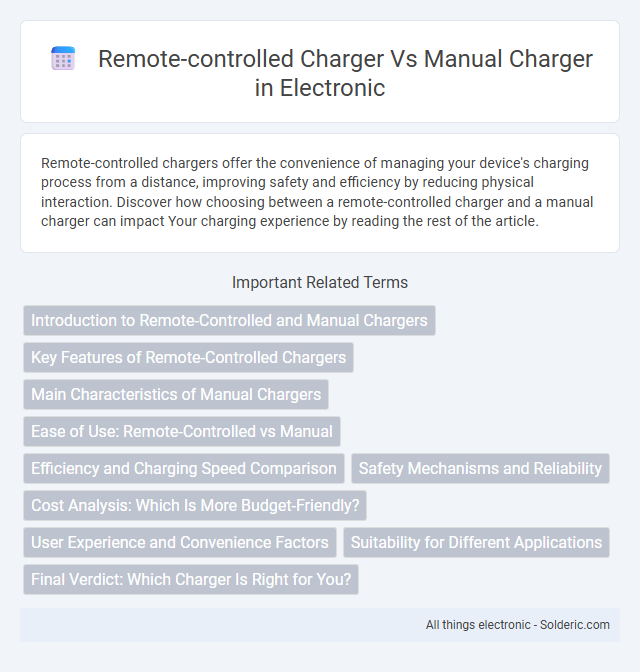Remote-controlled chargers offer the convenience of managing your device's charging process from a distance, improving safety and efficiency by reducing physical interaction. Discover how choosing between a remote-controlled charger and a manual charger can impact Your charging experience by reading the rest of the article.
Comparison Table
| Feature | Remote-Controlled Charger | Manual Charger |
|---|---|---|
| Operation | Controlled remotely via app or remote device | Requires manual connection and adjustment |
| Convenience | High - allows charging without physical interaction | Low - user must be physically present |
| Charging Speed | Typically adjustable remotely | Fixed or adjustable manually |
| User Interface | Digital, app-based or remote control | Physical buttons or switches |
| Safety Features | Integrated safety protocols with remote monitoring | Dependent on manual oversight |
| Cost | Higher initial investment | Lower upfront cost |
| Maintenance | Requires software updates and occasional hardware checks | Simple mechanical maintenance |
| Ideal Use Case | Best for convenience and automation | Suitable for basic, low-budget charging needs |
Introduction to Remote-Controlled and Manual Chargers
Remote-controlled chargers offer the convenience of wireless operation, allowing you to start and stop charging without physically accessing the device, which enhances safety and ease of use in various environments. Manual chargers require direct interaction, typically involving plugging in cables and adjusting settings by hand, providing straightforward control but less flexibility compared to remote models. Understanding the differences helps you choose the best charging solution for your needs, balancing automation and user control.
Key Features of Remote-Controlled Chargers
Remote-controlled chargers offer key features such as wireless operation, allowing you to control charging from a distance, enhancing convenience and safety. They often include programmable settings, real-time monitoring, and automatic shutoff functions that optimize battery health and prevent overcharging. These advanced capabilities provide greater control over the charging process compared to manual chargers, which require physical interaction and constant supervision.
Main Characteristics of Manual Chargers
Manual chargers are typically compact, lightweight, and cost-effective, making them easy to transport and operate without the need for external power sources. They require physical effort to generate electrical energy, which can provide a reliable charging method in remote or emergency situations where automated options are unavailable. You benefit from their simple design and low maintenance, ensuring durability and long-term usability without dependence on complex technology.
Ease of Use: Remote-Controlled vs Manual
Remote-controlled chargers offer superior ease of use by allowing you to start, stop, and monitor charging from a distance, eliminating the need for manual intervention. Manual chargers require physical presence to connect, disconnect, and adjust settings, which can be time-consuming and less convenient. Incorporating remote-controlled technology enhances user comfort and operational efficiency, especially in busy or hard-to-reach charging environments.
Efficiency and Charging Speed Comparison
Remote-controlled chargers offer enhanced efficiency by allowing users to monitor and adjust charging settings remotely, reducing energy waste and optimizing charging cycles. These chargers typically provide faster charging speeds due to intelligent power management and real-time performance adjustments. In contrast, manual chargers require constant physical interaction, which can lead to suboptimal charging and longer charging times.
Safety Mechanisms and Reliability
Remote-controlled chargers enhance safety mechanisms by allowing you to monitor and control charging processes from a distance, reducing risks of overheating, short circuits, and accidental disconnections through automated shutoff features. Manual chargers rely heavily on user vigilance, which increases the possibility of human error and inconsistent safety checks, potentially compromising the device's reliability. The integration of remote monitoring systems in chargers provides consistent performance and proactive fault detection, ensuring higher reliability compared to traditional manual operation.
Cost Analysis: Which Is More Budget-Friendly?
Remote-controlled chargers generally have higher upfront costs due to advanced technology and added convenience features, while manual chargers are more affordable and cost-effective for basic charging needs. Maintenance expenses tend to be lower for manual chargers because of their simpler design and fewer electronic components. For budget-conscious buyers, manual chargers offer a more economical choice, whereas remote-controlled chargers provide enhanced functionality at a premium price.
User Experience and Convenience Factors
Remote-controlled chargers offer enhanced user experience by enabling you to start, stop, and monitor charging sessions from a distance, providing superior convenience especially in outdoor or hard-to-reach locations. Manual chargers require physical interaction, which can be less efficient and time-consuming, especially in poor weather or low-light conditions. The ability to control charging remotely increases flexibility and reduces the effort needed, ultimately optimizing your daily device management.
Suitability for Different Applications
Remote-controlled chargers offer precise control and automation, making them ideal for complex or hazardous environments where safety and monitoring are critical. Manual chargers, favored for their simplicity and cost-effectiveness, suit basic or low-frequency charging needs, especially in settings where direct user intervention is convenient. Your choice depends on the specific application requirements, balancing automation benefits with hands-on control.
Final Verdict: Which Charger Is Right for You?
Remote-controlled chargers offer convenience and precision, allowing users to start, stop, and monitor charging from a distance, ideal for those valuing ease of use and advanced technology. Manual chargers provide simplicity, reliability, and often lower cost, making them suitable for users who prefer straightforward operation without extra features. Choosing the right charger depends on your budget, desired control level, and how frequently you need to manage charging sessions remotely.
remote-controlled charger vs manual charger Infographic

 solderic.com
solderic.com